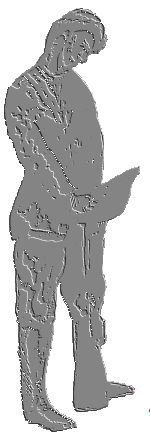 |
THE IRISH IN UNIFORM
THE IRISH GUARDS |
 |
Men of The Irish Guards on sentry duty at the Town Gate of Mons, Belgium on Armistice Day 11 November 1918 (IWM). |
| The Irish Guards were raised
as a Regiment in the year 1900 by order of Queen
Victoria, in honour of the brave Irishmen who fought in
the British Army's South African Campaigns. The creation
of The Irish Guards was ordered by Her Majesty following
a suggestion in 1900 from Lord Wolseley that the Irish
Regiments of the British Army should wear the shamrock in
their headdress on 17th. March (St. Patrick's Day) each
year as a mark of The Crown's appreciation of their
exceptional gallantry at Ladysmith, South Africa during
the Boer War. During the battles at Ladysmith and
Bloemfontein the Irishmen of The Inniskilling Fusiliers,
The Dublin Fusiliers and The Connaught Rangers had
particularly distinguished themselves by their bravery.
An Irish M.P. then suggested in Parliament that as there
were already regiments of Scots Guards and English
Guards, a regiment of Irish Guards should be created.
Holder of the regimental serial number 1 was Colour
Sergeant Conroy who was transferred from The Royal
Munster Fusiliers. The Irish Guards' first Commanding
Officer was Irishman Field Marshal Lord Roberts. The
Regiment received its first colours from His Majesty King
Edward VII at a parade held on Horse Guards Parade,
London in May 1902. From that year, the Irish Guards
adopted as its official mascot a pedigree Irish
Wolfhound, and one of that breed has taken part in its
formal parades ever since, wearing a specially
embroidered coat of livery. At the outbreak of The Great War, The Irish Guards were quartered in Wellington Barracks, London and left there for the battlefields of France on 12 August 1914. Almost the entire complement of 1100 other ranks and 32 officers were Irish-born. The Regiment landed at Le havre as part of the British Expeditionary Force, 4(Guards) Brigade, 2nd. Division. They were charged with the task of covering the retreat from Mons to the River Aisne and took part in fierce fighting with the German Army at Landrecies on 23 August, when their Commanding Officer, Lieutenant-Colonel G.H. Morris, was killed. Together with the rest of The British Expeditionary Force, The Irish Guards from September 1914 onwards were engaged in lengthy trench warfare in Northern France in appalling conditions. The Year 1914 saw the formation of a 2nd. Reserve Battalion, which then became the 3rd. Battalion and remained at Warley. In July 1915 the 2nd. Battalion of The Irish Guards was formed at Warley Barracks and joined its companion the 1st. Battalion in France and Flanders for the remainder of The Great War. The fighting spirit of these Irishmen gave rise to many incidents of bravery during the days of that horrendous conflict. Perhaps one of the most famous acts of gallantry of men of The Irish Guards was that of Lance-Corporal Michael O'Lear, who won that regiment's first Victoria Cross. The words of his citation, published on 18 February 1915 read thus:- "O'Leary, No. 3556, L/CPL. Michael. Ist. Battalion. Date of act of bravery: 1 February 1915. When forming one of the storming party which advanced against the enemy's barricades, he rushed to the front and himself killed five Germans who were holding the first barricade, after which he attacked a second barricade about 60 yards further on, which he captured after killing three of the enemy and making prisoners of two more. L/Cpl/ O'Leary thus practically captured the enemy's position by himself, and prevented the rest of the attacking party being fired upon." In 1917 two Irish Guardsmen received The Victoria Cross medal for their heroism in the same attack on Ney Copse, Broembroek, Belgium. These were Lance-Sergeant John Moyney and Private Thomas Woodcock. John Moyney's party was surrounded by the enemy, but managed to hold out for 96 hours. They evaded capture, drove off an enemy attack and then managed to retreat to the British lines without any losses. Details of Lance-Sergeant Moyney's citation can be viewed via the "Tipperary medals" page of this website. In 1918 Lieutenant, Acting Lieutenant-Colonel J.N. Marshall, M.C., of The Irish Guards, was on detachment to the 16th. Battalion Lancashire Fusiliers and was commanding that unit at Catillon near the Sambre-Oise Canal. He was awarded a posthumous Victoria Cross for his bravery there on 4 November 1918. Altogether, the men of The Irish Guards in World War I gained almost 400 medals for their bravery - 67 Military Crosses, 77 Distinguished Conduct Medals, 277 Military Medals and 4 Victoria Crosses. In the cause of freedom in Europe, fought for so gallantly by the brave Irishmen of this regiment during World War I, 115 officers and 2235 other ranks gave their lives, 246 were taken prisoner, 195 officers and 5541 other ranks were wounded. On 2 July 2000, The Irish Guards were awarded the Freedom of the City of Liverpool, England, to mark the Regiment's 100th. year. On this day, fifty of the soldiers of The Irish Guards clad in full regimental dress uniform marched in parade through the streets of Liverpool carrying rifles with bayonets fixed. This privelege is one of those bestowed upon military units awarded the Freedom of a City. During the ceremony on 2 July 2000, the Lord Mayor of Liverpool, Eddie Clein, said, "Liverpool has very strong links with The Irish Guards and it is entirely appropriate that we should grant the Regiment, in its Centenary Year, the highest honour the City can confer. We hope the association with The Irish Guards will continue as strongly in the next century as it has during the last 100 years". |
This site
webcrafted for The Fame of Tipperary Group, Tipperary
Town, County Tipperary, Ireland by the The WebWizards© at The
Plug-in Office ®, e-mail to plugin@iol.ie or Jay Rufus All text, backgrounds, graphics, images Copyright © 2000/2001 The WebWizards© or as acknowledged. |